Man Martin's Blog, page 129
April 25, 2014
V is for Vulture
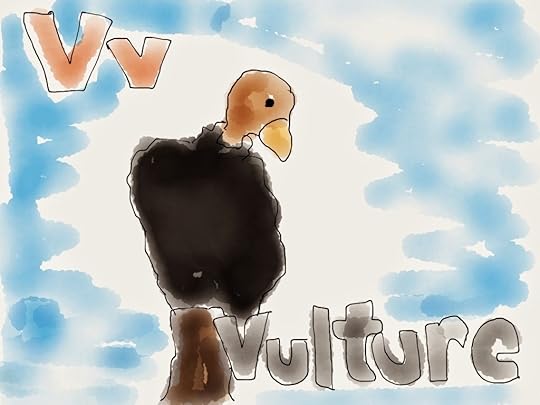 V is for Vulture.
V is for Vulture.I have a theory that the number of highways has had a direct correlation to the increase in the number of vultures. This is only conjecture and is neither here nor there, but it must be correct, right? And yet many species of vulture are endangered.
Humans have great dislike for vultures, and I myself would rather behold a flock of bluebirds on my front porch than a flock of vultures. A the collective noun for vultures, by the way, is a kettle of vultures. This is when they're in flight. When they're perched in trees, they're called a committee, and when they're eating, they're called a wake.
Actually, the vulture is not an animal, it is three different animals at least. Allow me to explain. The birds we lump under the term "vulture" actually refers to three different groups of birds that are not closely related, but resemble each other in behavior and appearance because of convergent evolution. If you fly around looking for dead things to eat, eventually you'll wind up looking like a vulture. The fact that vultures belong to three different species tells us a couple of things. 1. Evolution really needs vultures because if there isn't one handy, it'll come up with one. 2. When it comes to vultures, most people don't take the time to discern the subtle differences, and yet those same people will go on and on about how every sunset is unique and no two snowflakes are alike.
Vultures serve an indispensable service for which we look down on them. And why? Because they eat dead things. Well, check your refrigerator, Chuckles, and let me know how many live animals you have in there. Humans and vultures both eat dead things. Humans pay someone to bring dead things to them is the main difference. That, and that vultures can fly.
Published on April 25, 2014 03:32
April 24, 2014
U is for Unicorn
 U is for Unicorn.
U is for Unicorn.You will say the unicorn is purely mythological, but I say it is not. The unicorn is clearly a rhinoceros as imagined by someone who'd heard a rhinoceros described but never seen one for himself. "But," you protest, "a unicorn is a horse, and a rhinoceros looks nothing like a horse." Bear in mind that hippopotamus means "water horse." A hippopotamus resembles a horse no more closely than a rhinoceros. Clearly, the ancients had a much broader and looser idea of what horses look like than we do.
Marco Polo described unicorns as scarcely smaller than elephants. They have the hair of a buffalo and feet like an elephant's. They have a single large black horn in the middle of the forehead... They have a head like a wild boar's… They spend their time by preference wallowing in mud and slime. They are very ugly brutes to look at.
The modern unicorn, unlike the rhinoceros, is a thing of beauty, but it has been photo-shopped.
The unicorn horn, called an alicorn, was believed to have medicinal properties based on the general notion that anything rare and wonderful is worth chopping off and grinding into powder. Unfortunately unicorns were not lovable beasts like you see on the covers of little girls' lunchboxes. They were fierce and dangerous. They had horns on their heads and weren't afraid to use them.
One way to catch a unicorn was to stand in front of a tree and holler insulting remarks at it such as, "Hey, one-horn! You look like a rhinoceros!" Then when the unicorn came charging, step out of the way at the very last second and boink! The unicorn would drive its horn into the tree and be stuck.
The preferred method, however, was to find a virgin. Virgins are almost rare as unicorns, but if you could get a virgin, have her sit in a secluded place and wait. Pretty soon a unicorn would come and put its head in her lap, guaranteed. Unicorns are drawn to virgins like flies to cow poop.
This is surely one of the goofier notions ever set forth, and we owe it to none other than Leonardo Da Vinci, who records this "fact" in one of his notebooks. I imagine Leonardo had a good laugh about this from the grave - the unicorn tidbit must've been a booby trap for unwary chumps who went through his papers after his death looking for ideas to steal.
Published on April 24, 2014 03:18
April 23, 2014
T is for Tapir
 T is for Tapir.
T is for Tapir.The tapir looks like a pig, only with a more flexible snout. Except, it's not a pig. It's more closely related to horses and rhinoceroses. About 55 million years ago, there were some odd-toed ungulates hanging around in Asia. Some of them said, "We're going to evolve into magnificent creatures that will gallop and whinny." Others said, "We will evolve into formidable creatures with horns growing out of our faces." The tapir ancestors said, "We're going to evolve into pig-like animals, but with a more flexible snout." The others said, "Have it your way."
Tapirs don't have many natural predators, but due to habitat loss are considered vulnerable.
They keep their snouts to the ground in search of food, and enjoy nothing more than wallowing in some nice refreshing mud to cool down. Tapirs are very nice animals and they deserve all good things, but their lifestyle sounds a little like a pig, doesn't it? Again, I'm not judging, I'm just observing. This is what scientists call "convergent evolution." Species that occupy similar niches in similar habitats end up adapting in similar ways. Bottom line, if you live like a pig for long enough, eventually you'll turn into one.
Published on April 23, 2014 02:32
April 22, 2014
S is for Sphinx
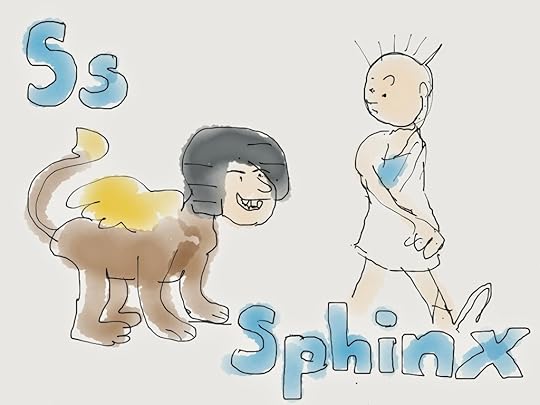 S is for Sphinx.
S is for Sphinx.If you have the body of a lion and the head of a human, you can qualify as a sphinx, but if you really want to go whole-hog, you need the wings of an eagle as well.
According to Greeks, the Sphinx was the daughter of the two-headed dog Orthus - brother of the more famous, three-headed Cerberus. (Hades could have used Orthus as a guard dog, but he was like, "Who wants to deal with a two-headed mutt?") The mother was the Chimera, an animal with a snake for a tail, a lion's head and a goat's head. The goat's head seems not so much terrifying as inconvenient. In any case, the Greeks believed that if a two-headed dog mated with a lion-goat-headed snake-tailed monster, the result would naturally be a human-headed lion, possibly with wings.
The Sphinx stood at the gates of Thebes, a city in Egypt, asking a riddle, and if you didn't know the answer, she'd strangle you. You already know the riddle and the answer because it's pretty old, but in those days, no one had heard it, and she killed a lot of people. Why someone with a lion's body would strangle people is another riddle altogether.
The name Sphinx means strangler, but it's really just an example of how the Greeks got an Egyptian myth all bungled up. Sphinx is probably a corruption of Shesepankh, which meant living image and referred to the statue of the Sphinx, specifically the Great Sphinx of Giza. Far from being a monster, she symbolized the power of the pharaohs.
That's the way it is sometimes. You create a monumental work of art, symbol of your national pride, and your neighbors turn it into a monster.
Published on April 22, 2014 02:49
April 21, 2014
R is for Rock Hyrax
 R is for Rock Hyrax.
R is for Rock Hyrax.Looks like a rodent, doesn't it? It's not, though, it's a whole nother thing. Its closest relatives are the modern-day elephant and the manatee. Take a minute to get your head around the idea that elephants and manatees are related to each other.
They are social and noisy and they live in rocky areas in Central Africa. They spend a lot of time sunning themselves because they have incomplete thermoregulation, or at least that's the excuse they give.
Rock Hyraxes are not kosher, which is surprising Leviticus goes into that much detail, but they do rate a favorable mention in Proverbs, "The rock badgers are a people not mighty, yet they make their home in the cliffs."
In addition to Rock Badgers, the Rock Hyrax are known as Rock Rabbits, Dassies, Pimbis, Peleles, Wibaris, Klipdas, and Ne'ers. But Hyrax is the coolest name because it sounds the most like something Dr. Seuss would have come up with.
Published on April 21, 2014 02:48
April 20, 2014
Bonus Letter: T is for Tiktaalik Roseae
 T is for Tiktaalik Roseae.
T is for Tiktaalik Roseae.According to the time-honored rules of the A-to-Z Blogging Challenge, I'm permitted Sundays off, so the number of days in April and number of letters in the alphabet will come out even. I'm using Sundays, however, to catch up on animals that "slipped through the cracks," as it were.
The Tiktaalik, or lobe-finned fish, may be the evolutionary link between fish and amphibians: ancestor, therefore, of all us land-dwelling chordates. The front fins of the Tiktaalik were not your ordinary fins; they were designed to bear weight. Moreover, they have wrist bones, and even structures resembling fingers. Little holes behind the eyes suggest it had lungs as well as gills.
This, ladies and gentlemen, is the living incarnation of the "Darwin Fish," pictured on chromium bumper-stickers throughout the land.
Why it evolved the way it did, why anything evolved the way it did, was necessity. In its specific environment, this remote ancestor of ours simply had to venture onto land or die. We didn't leave the sea willingly; we were chased.
Published on April 20, 2014 03:32
April 19, 2014
Q is for Quetzacoatl
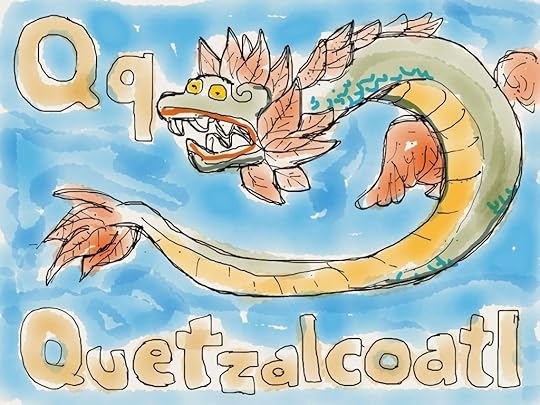 Q is for Quetzacoatl.
Q is for Quetzacoatl.Questzacoatl is the feathered serpent of Aztec mythology. According to the story, he was not only God of the morning star, but the giver of books, and the one who introduced corn.
When I was a kid, I learned in school that Cortes pretty much rolled over the Aztecs like a steamroller through daffodils because Montezuma believed he was the returning god, Quetzaocoatl. (Silly Aztecs! Ha-ha!) Turns out though, this may have been only propaganda from Cortes himself proving how gullible the natives were. In reality, the Aztecs were not so easily fooled. "You, Quetzacoatl? You're nothing like Quetzacoatl. For one thing, he's a snake. For another thing, feathers."
Mormons believe Quetzacoatl was actually Jesus Christ, who according to their religion, visited the Americas after his resurrection. Again, the Aztecs would be like, "Jesus, Quetzacoatl? Jesus is nothing like Quetzaoatl. For one thing, he's not a snake. For another thing, feathers."
What Quetzacoatl clearly resembles to yours truly is a Chinese dragon. What to make of that, however, I have no idea.
Published on April 19, 2014 03:20
April 18, 2014
P is for Piranha
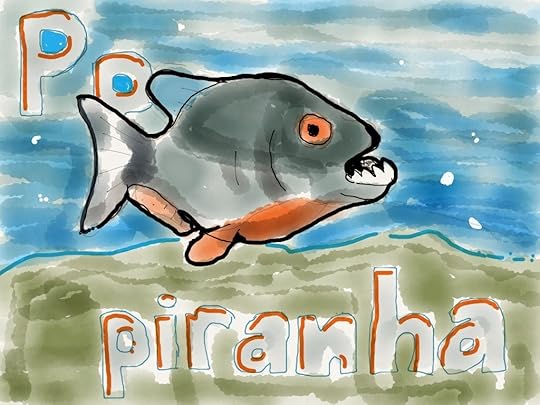 P is for Piranha.
P is for Piranha.Teddy Roosevelt visited the Amazon where the natives had rigged up a show for him. They threw a bull into the river where piranha ripped it to shreds. Teddy was mightily impressed and later wrote that the piranha was more vicious than the shark or barracuda. What the natives didn't tell Teddy was they'd blocked off the river beforehand and been starving the piranhas for days. Even guppies would get a little feisty in that predicament.
Nevertheless, a piranha is no guppy. There have been numerous documented human attacks - some fatal - over the past few years, including groups of fifteen to one hundred bathers. Adding up all the folks involved in piranha attacks since 2011, according to Wikipedia, I get the number 287. Damn. For shark attacks in the same period, again, using Wikipedia, I come up with 225. Number of alligator attacks? About 9.
Okay. So piranha may not have been quite the monsters TR thought, but they're still pretty impressive. And here's one final fact I find kind of creepy. What makes piranha so formidable is they hunt in schools. But they don't do that to make them more effective hunters, oh, no. They do it because they're afraid. They're protecting themselves from things that eat them. So next time you're swimming in the Amazon, remember, it's not just the piranha you have to watch for, it's all the things that eat piranha.
Published on April 18, 2014 02:36
April 17, 2014
O is for Opossum
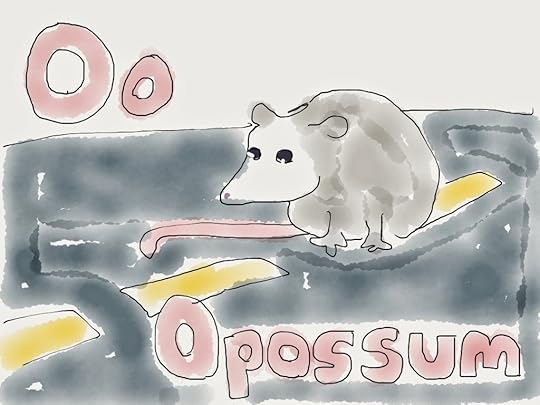 O is for Opossum.
O is for Opossum.It is not the same as a possum, which is a marsupial native to Australia. It is a marsupial, however, and the only marsupial in the Americas. Opossums do have semi-prehensile tails, but not nearly prehensile enough to hang from a branch like they do in Disney movies. They also do "play possum," and their act is much more convincing than you may have thought. When hissing and baring its teeth don't do the trick, the opossum not only goes completely immobile - in a creepily realistic impression of rigor mortis - it excretes a green fluid from its anus that smells like rotting flesh.
Opossum is edible, if you're hungry enough, but bear in mind it will poop itself with green slime somewhere along the way. According to the Joy of Cooking, the opossum should be caged for ten days and fed on milk and cereal. Then it should be cleaned but not skinned; Joy of Cooking is very specific on this part. Then put it in simmering water until the hair plucks out easily, and then scrape off the skin.
Hungry yet?
Remove the small red glands from under the legs and shoulder blades. Parblanch for about twenty minutes, then roast as you would for rabbit.
On second thought, don't bother.
Published on April 17, 2014 02:58
April 16, 2014
N is for Neanderthal
 N is for Neanderthal.
N is for Neanderthal.Neanderthals dominated Europe for tens of thousands of years. Then, about 60,000 years ago, when humans emerged from Africa, the Neanderthals began to die out, which scientists find mysterious. (Hint: It has to do with humans emerging from Africa.)
Although there are traces of Neanderthal DNA among humans, the Neanderthal was not our ancestor but a whole nother species. It would be nice to believe that humans overwhelmed them with superior brainpower, but the reality is we probably just had a much faster reproduction rate. We weren't smarter, just hornier.
Contrary to what you might think, Neanderthals weren't hairy creatures that walked bent over and grunted at each other. They stood upright, had a language, and used tools. If you saw a Neanderthal walking by dressed in modern clothes, you would not notice anything particularly strange.
Neanderthals cared for their sick and buried their dead. On the other hand, at least one scientist says they raped and killed humans and weren't above eating human flesh. So all in all, they weren't all that different from us.
Published on April 16, 2014 02:35



